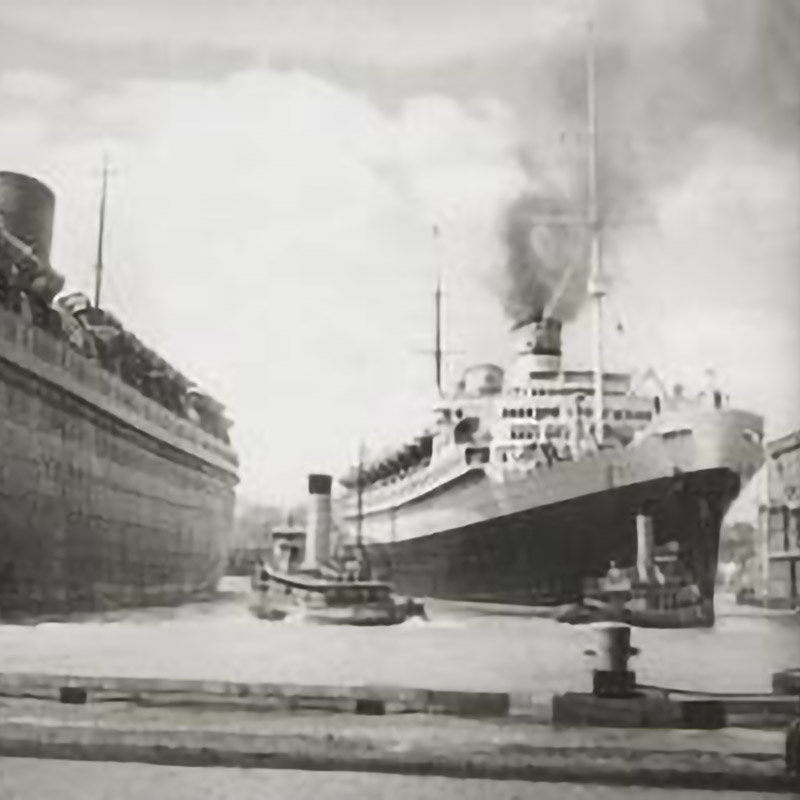Family Album n.3
To complete the splendid documentation
of the family which lived in the Museum-home of Boschi Di Stefano in Milan, we come, after numbers one and two, finally to Family Album number three. This third companion guide adds a new record of their travel to that of the everyday lives (number one) and the free time (number two) of a singular couple belonging to the upper Lombard bourgeoisie. We are in the first half of the last century, the personalities are curious, educated and well-off, still among the few who can afford such adventurous tourism (e.g. in the Middle East and in Northern Europe), but they are careful to document it as a life-enriching experience to be remembered. A camera, although used in an amateur fashion, is found to be just the tool to remind the protagonists of their delightful experiences (and also to give us a record of their period).
The photographs presented here are full of interesting features, but we have decided to focus on the places the couple travelled to, the means of transport they used, their travel clothes and also the angles chosen to compose the individual photographs, often curious and ironic, or amazed and almost unbelieving of the reality they are framing. The main places that Marieda Di Stefano and Antonio Boschi travelled to – as already mentioned – were the lands of the Middle East (Egypt in particular) and those lapped by the seas of northern Europe in their cruises. The first followed the same routes which many “young adventurers” had chosen as far back as the middle of the 19th Century to broaden the European horizons of the previous classic Grands Tours to include the ancient cultures of Egypt, Arabia and the Fertile Crescent. The many who followed it included the Lombard marquis and naturalist Giammartino Arconati Visconti who had travelled to Arabia Petraea in 1865. (I viaggi di Giammartino Arconati Visconti, by Maria Cristina Antonini Berti, 2009).
The cold lands of northern Europe, on the other hand, are a sort of new discovery by this 20th Century Milanese couple, perhaps offering the challenge of a comparison to the no less difficult middle eastern landscapes and climates, but equally rich in charm and fascination. Before that journey, they had made other trips to Berlin and Brussels. Another quite exceptional journey for the period was their trip to Japan.


They preferred to sail by steamship for all their most demanding expeditions. It sometimes gave them wonders greater than could be imagined, as shown, for example, by the photographs of the Corinth Canal, taken from the quarterdeck of the steamship Stella d’Italia, which carried our luxury tourists. No less significant is Marieda’s look from the bridge of a ship at sea (we don’t know which), with her head into the wind blowing through her hair, with the broad expanse of water in front of her. It is also amusing to view the period of those trips through the lens of the clothes and hairstyles of the subjects.
Those of the men and all the winter styles are little different from those of today, but Marieda’s summer clothes and those of her female friends deserve a mention. They are light, voluminous, but “decent” to a tee. They usually cover the legs and of course are accompanied by appropriate hats, small in winter and broad and light in summer. The bathing costumes are full bodied not just for the women, but also for the men. Definitely not those of today! In addition to these features, connected with the places they visited in the world, the means of transport employed and their clothing, it is also very interesting to look at the shots taken by our protagonists to remind them of their travels. The slightly static, and less fascinating, poses in front of the lens were inevitable. The snapshots, on the other hand, are of great effect, the one in the streets of Brussels, that of Marieda with a donkey, in Athens, and that of them playing in the swimming pool on the steamship, Stella d’Italia, in 1932, or again that of the couple with friends on the same cruise. Even Antonio seems to have been taken by surprise on the bridge of the transatlantic liner Rex, which had just won the Blue Riband for the fastest Atlantic crossing.
However, Marieda could hardly not be expected to pose in front of the Pyramid of Chephren or the Sphinx. This seems to have been almost fatal for all the photos of their trip to Egypt, which are nevertheless splendid records of monuments which were so little known at the time. However, the portraits of Marieda “almost” posing in imitation of the ancient statutes and the photos of their trip with a donkey in the ancient Thebes are both curious and ironic. Even by the most modern standards Marieda climbing up the rigging of the steamship Pilsna in 1934 is also singular, as is their visit to the Faroe Islands and above all to Spitsbergen: Marieda stroking the large horns of an elk is perhaps the most memorable photo of that trip.
Unfortunately the only photograph we have of their expedition to Japan is this image of the couple in kimonos, but by their expressions our friends seem content and interested in the diversity of the country they are visiting, just as they often appear in all their wanderings of discovery in the world. Marieda and Antonio certainly explored the world for pleasure and this was made possible by their social, professional and cultural status. However, these photographs show that they always did so with curiosity and respect for all that is different, a simple but good lesson for so many tourists of today.
Giacomo Corna Pellegrini
